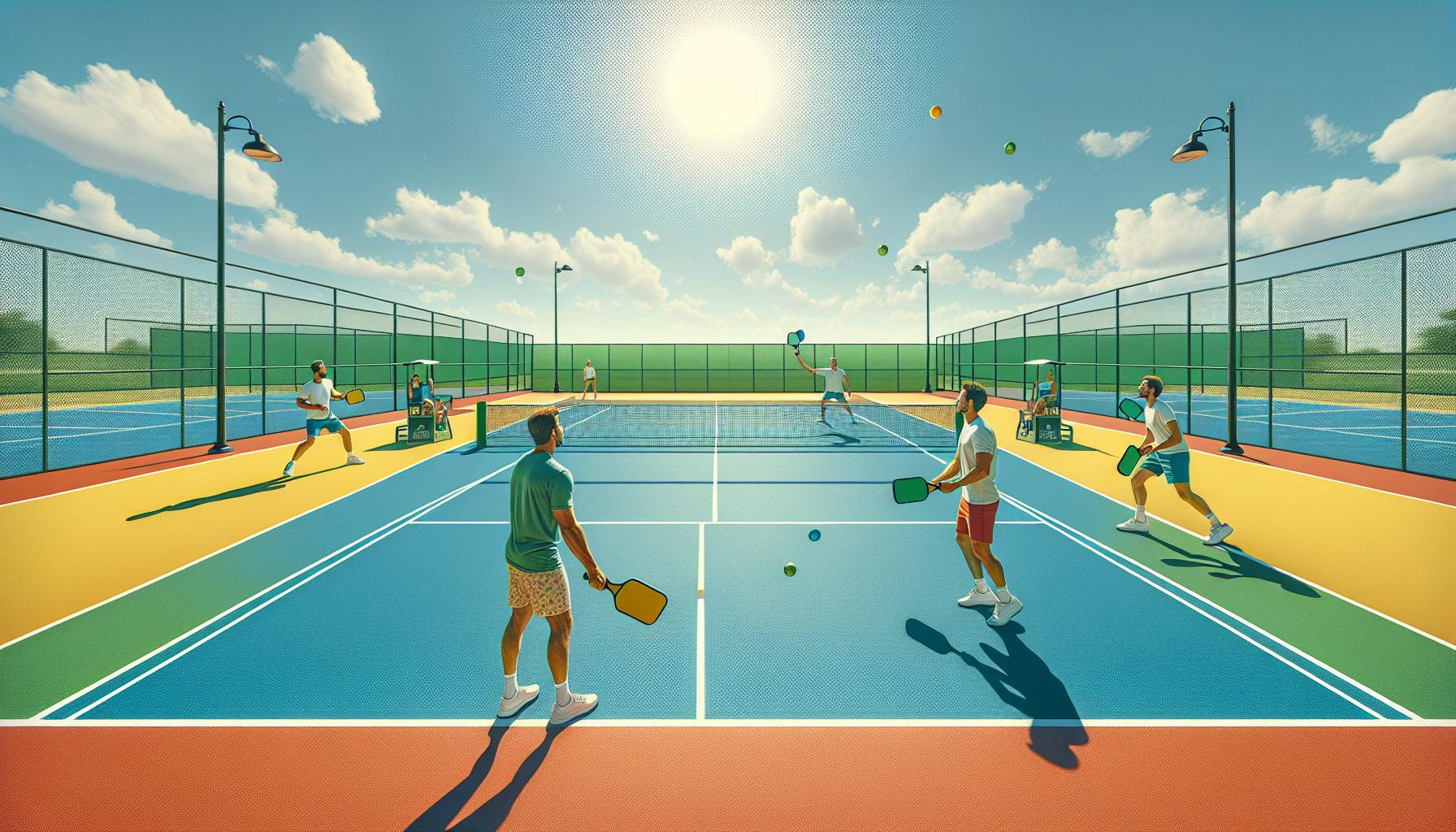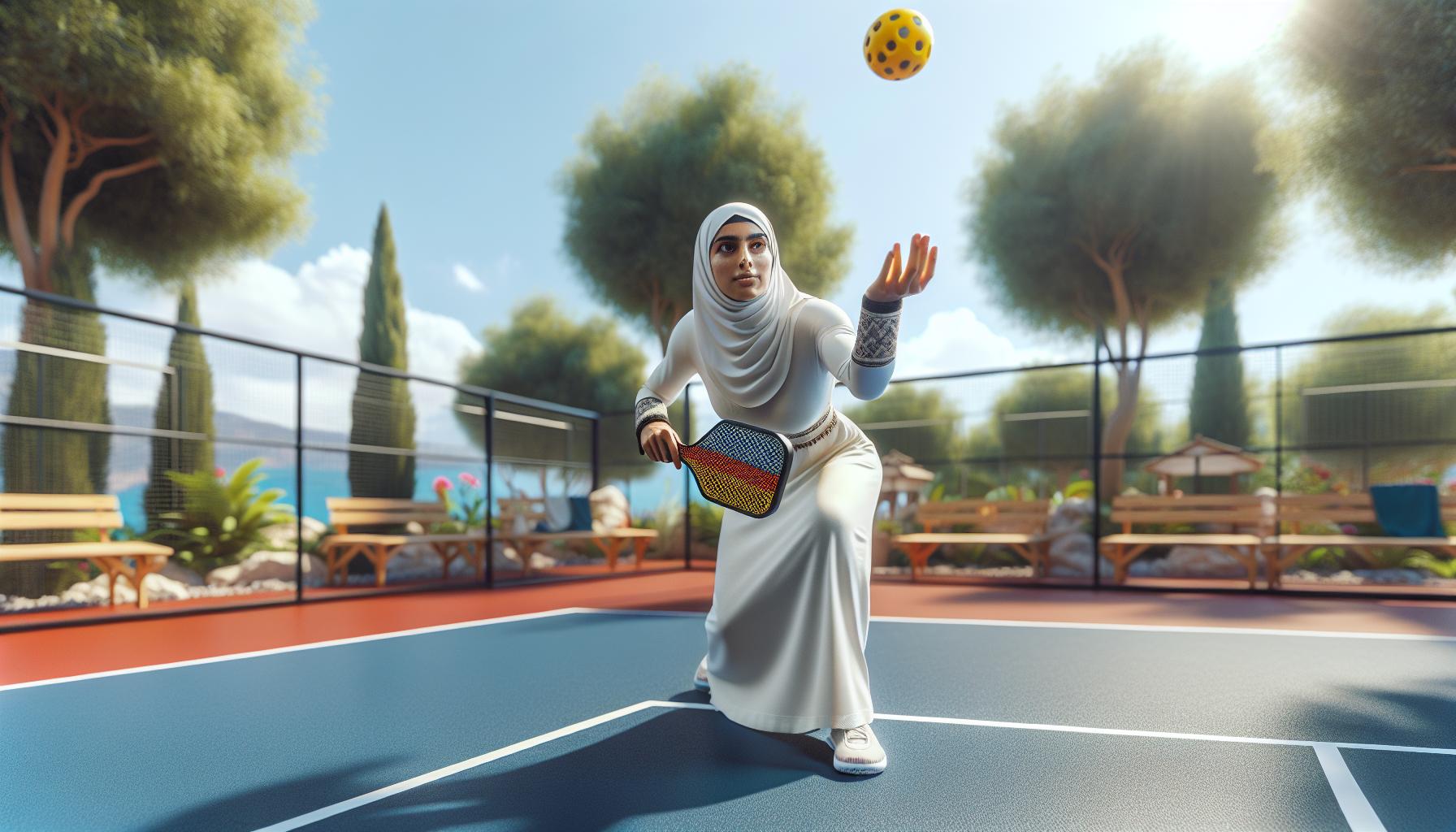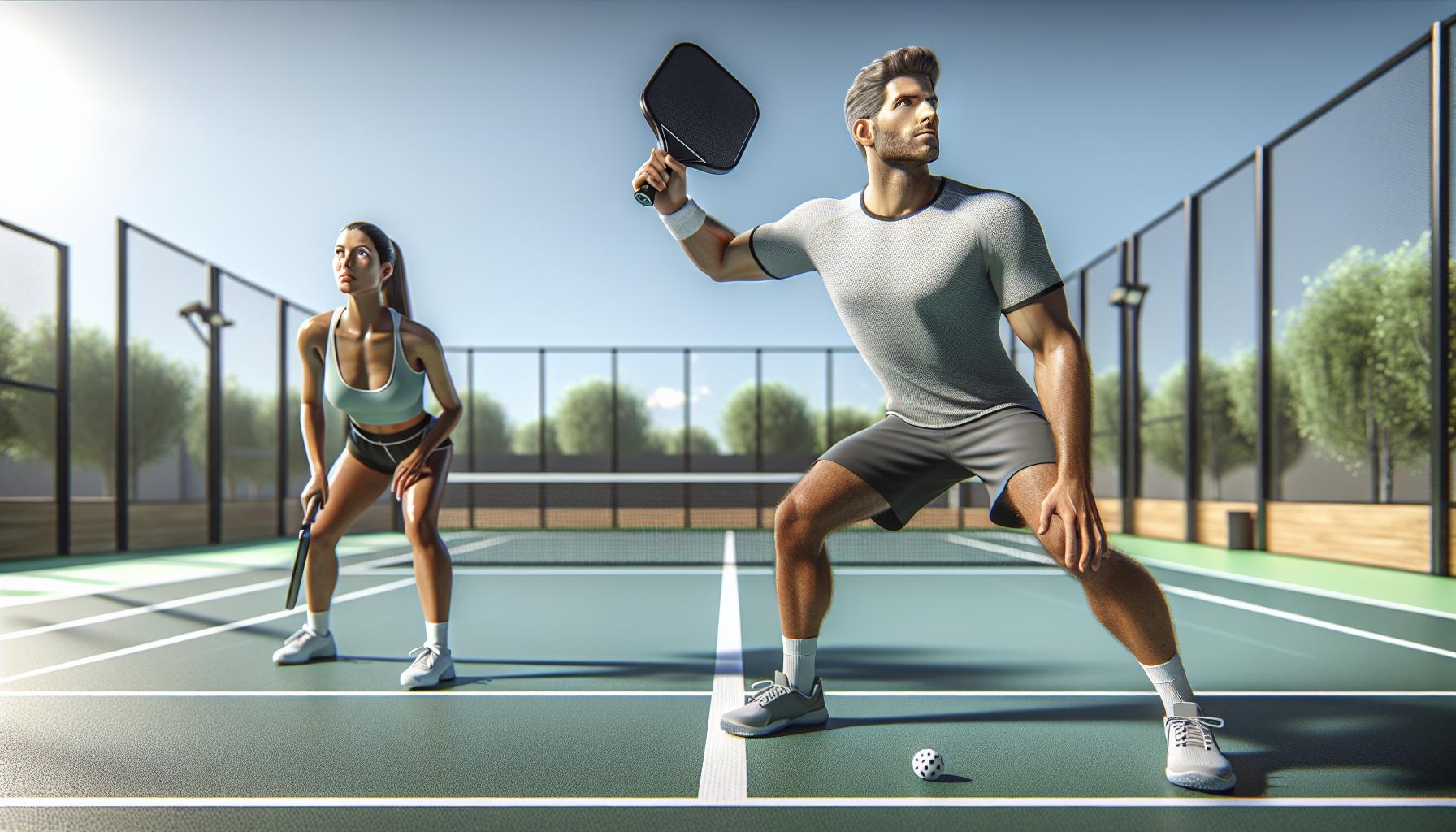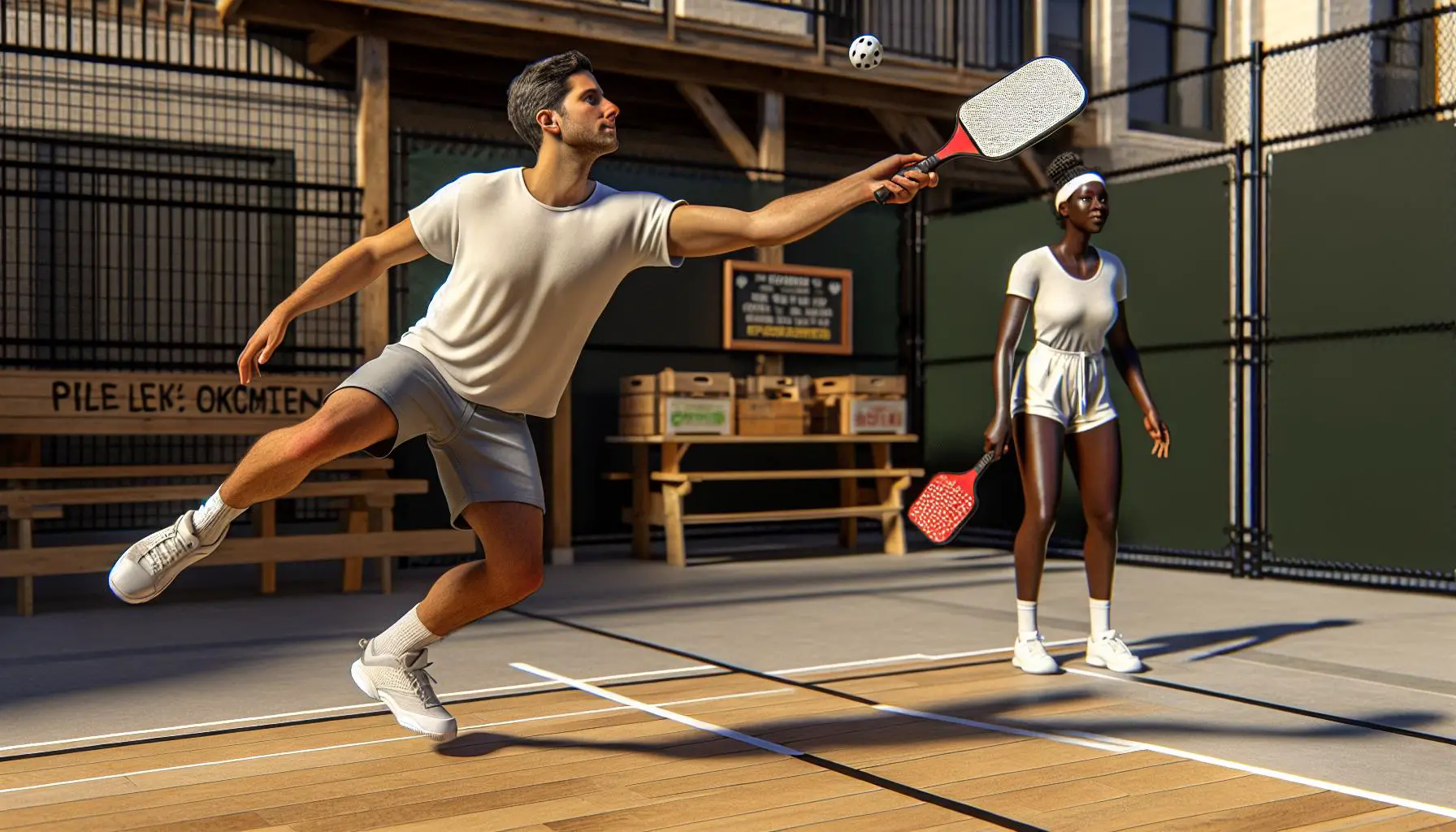Pickleball’s taking the world by storm, and it’s no wonder why. It’s fun, it’s social, and best of all, it’s easy to pick up. But before you hit the court with paddle in hand, there’s a bit you’ll need to know to get started.
Equipment Needed for Pickleball
Before diving into the world of pickleball, it’s important to gather the right equipment to play the game. Thankfully, pickleball doesn’t require a lot of gear, making it accessible for beginners.
The Basics
At the core of pickleball equipment are three essentials:
- Pickleball Paddles: Unlike tennis rackets, pickleball paddles are solid, without strings, and typically made from wood, composite, or graphite. Beginners might start with less expensive wooden paddles, but as one’s skills improve, upgrading to lighter and more responsive composite or graphite paddles can enhance the playing experience.
- Pickleballs: These are unique to the sport. They’re similar to wiffle balls but are specifically designed for pickleball play. There are two main types: outdoor and indoor pickleballs. Outdoor balls are slightly harder and have 40 holes, designed to withstand windy conditions, while indoor balls have 26 larger holes and are softer. Choosing the right ball depends on where you plan to play most often.
- Net: A pickleball net is a crucial part of the equipment. The net height is 36 inches at the sidelines and droops to 34 inches in the middle. Portable net systems are available for those who want to set up a game on any flat surface, offering great flexibility for players without access to dedicated pickleball courts.
Additional Gear
Aside from the basic equipment, there are a few additional items beginners might consider:
- Shoes: While dedicated pickleball shoes aren’t a necessity, wearing athletic shoes that provide good support and traction is important to avoid injuries. Shoes designed for tennis or similar sports can offer the appropriate support needed for the side-to-side action in pickleball.
- Apparel: Comfort is key when it comes to clothing for pickleball. Lightweight, breathable materials that allow for easy movement are ideal. Many players opt for athletic wear similar to that worn in tennis or badminton.
- Gloves: Some players choose to wear gloves to improve grip on the paddle, especially in hot weather when hands may sweat. This is optional and often comes down to personal preference.
- Eyewear: Safety glasses or sunglasses can protect the eyes from not only the sun but also from errant balls or paddle swings. While not mandatory, they can be a wise investment for those who play frequently.
Basic Rules of Pickleball

Pickleball is a sport that combines elements of tennis, badminton, and ping-pong, making it an easy game for beginners to pick up. However, understanding the basic rules is crucial for anyone stepping onto the pickleball court for the first time.
The court in pickleball is similar to a badminton court in size and layout. It’s divided into two equal squares with a net running across the middle. There’s a non-volley zone, often called “the kitchen,” that extends 7 feet from the net on both sides. Players are not allowed to volley (hit the ball in the air) within this zone.
Serving in pickleball must be done underhand with the paddle below the waist. The serve is made diagonally across the court to the opposite service square. Only one serve attempt is allowed, and the server continues to serve until a fault is made. An important rule for beginners to remember is that the serve must clear the non-volley zone.
After the ball is served, the double bounce rule comes into effect. This rule requires that the ball must bounce once on each side before volleys are allowed. This unique rule gives pickleball its distinctive rhythm and helps to level the playing field for players of all skill levels.
Scoring and Winning
Scoring in pickleball can be a bit unique. Games are typically played to 11 points, though they must be won by at least 2 points. Only the serving team can score a point. If the receiving team wins the rally, they gain the serve but no points. This scoring method emphasizes the importance of maintaining the serve and puts pressure on the serving team to perform well.
| Scoring Fact | Detail |
|---|---|
| Points needed to win | 11 |
| Winning margin | At least 2 points |
| Server advantage | Only the serving team can score points |
In terms of faults, these occur when the ball is hit out of bounds, does not clear the net, is volleyed from the non-volley zone, or does not follow the double bounce rule. Faults result in a loss of the serve or a point for the opposing team, depending on who made the fault.
Serving Rules

When stepping into the world of pickleball, mastering the serving rules is crucial for a strong start. Serving in pickleball sets the pace of the game, and understanding these guidelines will not only make one a competent player but also enhance the enjoyment of the game.
Firstly, serves must be underhand. This means the paddle must contact the ball below the waist level. The serving action involves an upward arc, ensuring the ball is hit in this manner requires precision and practice. Additionally, the server’s feet must stay behind the baseline during the serve, crossing this line before the ball is hit results in a fault.
Another important aspect of serving is the two-bounce rule. After the ball is served, it must bounce once on the opponent’s side before it can be returned, and then it must bounce once on the serving team’s side before being volleyed. This rule adds a strategic depth to the game, encouraging players to anticipate and react rather than just relying on the power of their serves.
Serving in pickleball also follows a specific sequence and rotation. The server continues to serve until a fault is made, at which point the service passes to the opponent. In doubles, the service alternates between the two players on a team each time they win back the service from their opponents. The serving side can only score points, giving serving a tactical advantage.
The server’s position is dictated by the score. In pickleball, if the serving team’s score is even, the player serves from the right service court. If the score is odd, the serve is made from the left service court. This rule ensures an equitable distribution of service opportunities across both sides of the court.
Finally, there’s a unique aspect to pickleball serving known as the “kitchen” or the non-volley zone. This is the 7-foot zone on either side of the net where the serve must clear, but within which players cannot volley the ball (hit it before it bounces). Players often find strategizing around the non-volley zone one of the more challenging and exciting aspects of pickleball.
- Serves must be underhand, with the paddle making contact with the ball below waist level.
- The ball must land in the opposite diagonal court.
- The server’s feet should not cross the baseline until after the ball is served.
- The serve initiates the two-b
Scoring in Pickleball

Understanding the scoring system in pickleball is crucial for beginners. It’s not just about keeping track of points; it’s about knowing how to strategize your game. In pickleball, the game is typically played to 11 points, but a team must win by at least 2 points. For tournaments or more competitive play, games might be to 15 or 21 points, again requiring a 2-point lead to secure a victory.
In pickleball, only the serving team can score points. This rule adds an extra layer of strategy to the game. When the serving team wins a rally, they score a point and continue to serve. If the receiving team wins the rally, they do not score but instead gain the right to serve, offering them a chance to score points. This back-and-forth continues until one team reaches the required number of points to win the game.
Scoring in pickleball also has its unique language. The score is always called out in three numbers: the serving team’s score first, then the receiving team’s score, and finally, the server number. For example, if the serving team has 5 points, the receiving team has 3, and the serving team is on their first serve, the score would be called out as “5-3-1”. This method ensures that all players on the court are aware of the score, who is serving, and which serve it is.
Serving Sequence and Scoring
The serve in pickleball plays a crucial role not only in starting the rally but also in determining scoring opportunities. Each time a service shifts to the other team (a side out), the first server serves from the right-hand court if their team has an even score and from the left-hand court if the score is odd. This sequence helps players keep track of the serving order and positions.
When the serving team wins a point, the server moves to the opposite side of the court for the next serve, maintaining the even/odd position rule. This rotation continues until a fault occurs, leading to a service change or until the second server loses the rally, at which point the serve shifts to the opponents.
- Always call the score before serving: This keeps everyone on the same page and avoids any confusion about the game status.
- Remember the sequence: Score of the serving team, score of the receiving team, then
Strategies for Beginners

Pickleball, while easy to pick up, involves strategic depth that can elevate a beginner’s game from basic to competitive. Understanding a few foundational strategies can significantly impact their performance and enjoyment of the game.
Serve Wisely
The serve in pickleball is the first opportunity to gain the upper hand in a rally. Beginners should focus on consistency over power. It’s tempting to smash a powerful serve, but a serve that’s consistently in play and strategically placed can be more effective. Playing to the weaker side of the opponent or aiming for the back court are good strategies. This forces the opponent to move more, increasing the chances of an error on their part.
Master the Kitchen
The non-volley zone, commonly referred to as the “kitchen,” requires players to strategize their movement and shots. Beginners should practice not stepping into the kitchen unless they are hitting a ball that bounces first. This area is a strategic point, especially for shots like dinks that can set up more aggressive plays. Players should aim to control this zone by placing slow, arcing shots that land in the opponent’s kitchen, making it difficult for them to return without stepping into the zone.
Exploit the Two-Bounce Rule
The two-bounce rule dictates that the ball must bounce once on each side before volleys can commence from either team. Beginners can use this rule to their advantage by developing a strategy to move opponents around the court. Placing the return of serve deep in the opponent’s side forces them away from the net, giving the serving team an opportunity to take control of the net first.
Use Shot Variety
Developing a variety of shots can confuse and outmaneuver opponents. Beginners should focus on mixing up their shots – from deep baseline shots to soft dinks in the kitchen. This variety keeps opponents guessing and unable to settle into a predictable pattern of play. Practicing different shots also helps in understanding when and where to use them during match play.
Develop a Power Defense
Defense is as crucial as offense in pickleball. A well-timed lob or a carefully placed return can shift the momentum of a game. Beginners should learn to view defensive plays as opportunities to reset the point or even gain the offensive. For instance, a deep lob can pull opponents away from the net, allowing the defensive team to move into a more advantageous position.
Conclusion
Armed with the basics of pickleball, beginners are now ready to step onto the court with confidence. From mastering the underhand serve to navigating the strategic depths of the “kitchen,” the journey into this exciting game is full of opportunities to learn and grow. Remembering the importance of the two-bounce rule and the nuances of scoring will not only keep the game fair but also incredibly engaging. As players venture into their pickleball adventures, focusing on serving strategies, shot variety, and a solid defense will pave the way for not just playing the game but excelling at it. So grab a paddle, find a court, and let the fun begin!














0 Comments